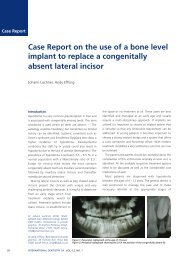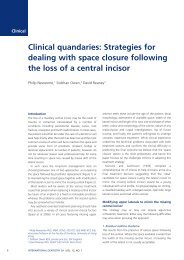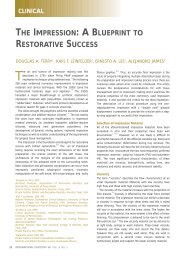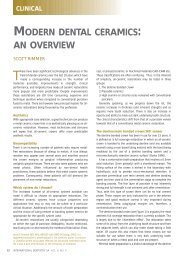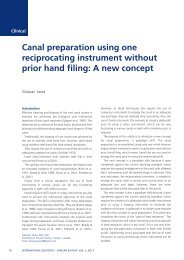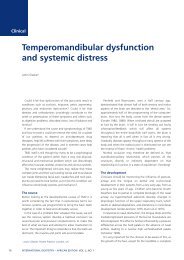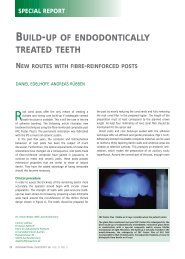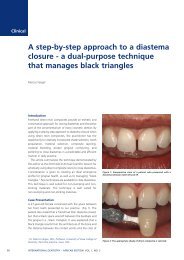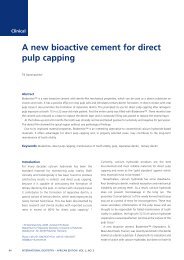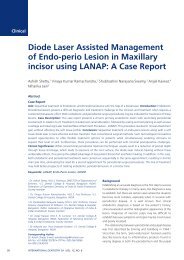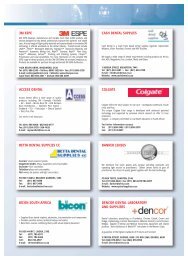On target with more brightness - International Dentistry SA - Modern ...
On target with more brightness - International Dentistry SA - Modern ...
On target with more brightness - International Dentistry SA - Modern ...
You also want an ePaper? Increase the reach of your titles
YUMPU automatically turns print PDFs into web optimized ePapers that Google loves.
Votteler<br />
Fig 11 Layered veneers on the model Fig 12 Try-in in the patient’s mouth<br />
Fig 13 Gold powder facilitates the final contouring and shaping of<br />
the restorations.<br />
structures and the body was achieved <strong>with</strong> Dentin/OE3 and<br />
the <strong>brightness</strong> value was adjusted. Various Enamel and<br />
Opal materials were used to complete the tooth shape on<br />
the labial side.<br />
To finish off the layering procedure for the main firing<br />
cycle, the restoration was framed <strong>with</strong> a layer of dentin to<br />
create a halo. The veneer was slightly over-contoured to<br />
compensate for material shrinkage. As a result, correction<br />
firing was obsolete (Fig 11).<br />
As this was the first time I used the new Value ingots for<br />
a patient case, I was keen to check the esthetic effect in<br />
the patient’s mouth. The image of the try-in clearly shows<br />
that a balanced translucent effect has been achieved in the<br />
restoration: no greying and no inappropriately intense<br />
masking of the substrate can be seen (Fig 12).<br />
High precision finishing<br />
Finishing the form and functional aspects of the restoration<br />
is an essential part of my work. The surface was given its<br />
final structure <strong>with</strong> rotary instruments before glaze firing<br />
54 INTERNATIONAL DENTISTRY – AFRICAN EDITION VOL. 1, NO. 2<br />
Fig 14 Completed veneers on the model<br />
was conducted – gold powder is of particular use in this<br />
respect (Fig 13). After glaze firing, the proximal contacts<br />
and the occlusion were checked on the uncut model. To<br />
complete the procedure in the dental laboratory, the<br />
restoration was manually polished on a polishing unit<br />
using a fine pumice/Sidol mixture and a water soaked felt<br />
wheel (Fig 14).<br />
Incorporating the restoration – a moment of<br />
suspense<br />
The enamel surface of the prepared teeth were etched <strong>with</strong><br />
37% orthophosphoric acid for thirty seconds and then<br />
rinsed <strong>with</strong> a water/air spray for sixty seconds. The threecomponent<br />
bonding agent (Syntac ® Classic) was applied<br />
according to the manufacturer’s directions for use. At the<br />
same time, the all-ceramic restorations were etched <strong>with</strong><br />
9% hydrofluoric acid and after twenty seconds carefully<br />
rinsed <strong>with</strong> water.<br />
Next, the restorations were cleaned <strong>with</strong> alcohol and<br />
subsequently silanated <strong>with</strong> Monobond Plus. Note: the



